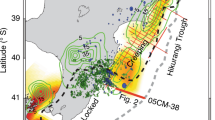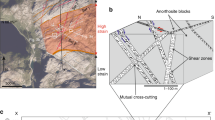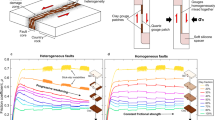Abstract
Earthquakes generated in subduction zones are caused by unstable movements along faults. This fault-slip instability is determined by frictional forces that depend on the temperature, pressure, morphology and deformation state of the fault rocks. Fault friction may also be influenced by preferred mineral orientations. Over-thrusting of rocks at the interface between a subducting slab and the overlying mantle wedge generates shear deformation that causes minerals to align1,2,3, and this preferred mineral orientation affects the propagation of shear seismic waves4,5,6. Here we use laboratory experiments to simulate fault slip in antigorite, the most abundant hydrous mineral phase within Earth’s upper mantle7. Using atomic force microscopy, we show that antigorite single crystals possess strong frictional anisotropy on their basal slip surface and that preferred mineral alignment extends this property to a regional scale. Depending on the alignment, fault movements can occur along a high-friction direction, creating stick-slip behaviour that generates earthquakes. In contrast, if movements occur along a low-friction direction, the mantle wedge will deform aseismically. Our results imply that mantle rocks in subduction-zone thrust faults can exhibit two opposite frictional behaviours, seismic and aseismic.
This is a preview of subscription content, access via your institution
Access options
Subscribe to this journal
Receive 12 print issues and online access
$259.00 per year
only $21.58 per issue
Buy this article
- Purchase on Springer Link
- Instant access to full article PDF
Prices may be subject to local taxes which are calculated during checkout




Similar content being viewed by others
References
Bezacier, L., Reynard, B., Bass, J. D., Sanchez-Valle, C. & Van de Moortèle, B Elasticity of antigorite, seismic detection of serpentinites, and anisotropy in subduction zones. Earth Planet. Sci. Lett. 289, 198–208 (2010).
Hirauchi, K., Michibayashi, K., Ueda, H. & Katayama, I. Spatial variations in antigorite fabric across a serpentinite subduction channel: Insights from the Ohmachi Seamount, Izu-Bonin frontal arc. Earth Planet. Sci. Lett. 299, 196–206 (2010).
Jung, H. Seismic anisotropy produced by serpentine in mantle wedge. Earth Planet. Sci. Lett. 307, 535–543 (2011).
Katayama, I., Hirauchi, K., Michibayashi, K. & Ando, J. Trench-parallel anisotropy produced by serpentine deformation in the hydrated mantle wedge. Nature 461, 1114–1117 (2009).
Mookherjee, M. & Capitani, G. C. Trench parallel anisotropy and large delay times: Elasticity and anisotropy of antigorite at high pressures. Geophys. Res. Lett. 38, L09315 (2011).
Faccenda, M., Burlini, L., Gerya, T. V. & Mainprice, D. Fault-induced seismic anisotropy by hydration in subducting oceanic plates. Nature 455, 1097–1100 (2008).
Hyndman, R. D. & Peacock, S. M. Serpentinization of the forearc mantle. Earth Planet. Sci. Lett. 212, 417–432 (2003).
Jones, C. H. How faults accommodate plate motion. Science 300, 1105–1106 (2003).
Eberhart-Phillips, D. et al. The 2002 Denali fault earthquake, Alaska: A large magnitude, slip-partitioned event. Science 300, 1113–1118 (2003).
McCaffrey, R. Oblique plate convergence, slip vectors, and forearc deformation. J. Geophys. Res. 97, 8905–8915 (1992).
Fitch, T. J. Plate convergence, transcurrent faults, and internal deformation adjacent to southeast Asia and the western Pacific. J. Geophys. Res. 77, 4432–4460 (1972).
Yu, G., Wesnousky, S. G. & Ekström, G. Slip partitioning along major convergent plate boundaries. Pure Appl. Geophys. 140, 183–210 (1993).
Liu, X., McNally, K. C. & Shen, Z. Evidence for a role of the downgoing slab in earthquake slip partitioning at oblique subduction zones. J. Geophys. Res. 100, 15351–15372 (1995).
Campione, M., Trabattoni, S. & Moret, M. Nanoscale mapping of frictional anisotropy. Tribol. Lett. 45, 219–224 (2011).
Capitani, G. C. & Mellini, M. The modulated crystal structure of antigorite: The (m = 17) polysome. Am. Miner. 89, 147–158 (2004).
Capitani, G. C. & Mellini, M. The crystal structure of a second antigorite polysome (m = 16), by single-crystal synchrotron diffraction. Am. Miner. 91, 394–399 (2006).
Palacios-Lidon, E. et al. TEM-assisted dynamic scanning force microscope imaging of (001) antigorite: Surfaces and steps on a modulated silicate. Am. Miner. 95, 673–685 (2010).
Zmitrowicz, A. Mathematical descriptions of anisotropic friction. Int. J. Solids Struct. 25, 837–862 (1989).
Campione, M. & Fumagalli, E. Friction anisotropy of the surface of organic crystals and its impact on scanning force microscopy. Phys. Rev. Lett. 105, 166103 (2010).
Choi, J. S. et al. Friction anisotropy–driven domain imaging on exfoliated monolayer graphene. Science 333, 607–610 (2011).
Park, J. Y. High frictional anisotropy of periodic and aperiodic directions on a quasicrystal surface. Science 309, 1354–1356 (2005).
Poli, S. & Schmidt, M. W. Petrology of subducted slabs. Annu. Rev. Earth Planet. Sci. 30, 207–235 (2002).
Li, Q., Tullis, T. E., Goldsby, D. & Carpick, R. W. Frictional ageing from interfacial bonding and the origins of rate and state friction. Nature 480, 233–236 (2011).
Grasselli, G. & Egger, P. Constitutive law for the shear strength of rock joints based on three-dimensional surface parameters. Int. J. Rock Mec. Min. 40, 25–40 (2003).
Hyndman, R. D., Yamano, M. & Oleskevich, D. A. The seismogenic zone of subduction thrust faults. Island Arc 6, 244–260 (1997).
Horcas, I. et al. WSXM: A software for scanning probe microscopy and a tool for nanotechnology. Rev. Sci. Instrum. 78, 013705 (2007).
Sul, O., Jang, S. & Yang, E. H. Step-edge calibration of torsional sensitivity for lateral force microscopy. Meas. Sci. Technol. 20, 115104 (2009).
Romano, E. et al. Combined use of AFM and FTIR in the analysis of the hydrogen termination of Si (100) surfaces. Microscopy: Science, Technology, Applications and Education 3, 1984–1992 (2010).
Acknowledgements
The microscopic characterization was performed at the Atomic Force Microscopy Laboratory of the Department of Materials Science, Università degli Studi di Milano Bicocca, thanks to the support of A. Sassella. We thank N. Malaspina for discussions and comments that improved this manuscript.
Author information
Authors and Affiliations
Contributions
M.C. performed the nanotribological analysis and developed the geophysical model, G.C.C. prepared natural samples and performed structural analysis. Both authors discussed the results and implications.
Corresponding author
Ethics declarations
Competing interests
The authors declare no competing financial interests.
Supplementary information
Supplementary Information
Supplementary Information (PDF 933 kb)
Rights and permissions
About this article
Cite this article
Campione, M., Capitani, G. Subduction-zone earthquake complexity related to frictional anisotropy in antigorite. Nature Geosci 6, 847–851 (2013). https://doi.org/10.1038/ngeo1905
Received:
Accepted:
Published:
Issue Date:
DOI: https://doi.org/10.1038/ngeo1905
This article is cited by
-
Dehydration of brucite + antigorite under mantle wedge conditions: insights from the direct comparison of microstructures before and after experiments
Contributions to Mineralogy and Petrology (2022)
-
First-principles investigations on the formation of H2O defects in lizardite with influence on the elastic property
Physics and Chemistry of Minerals (2019)
-
Switchable friction enabled by nanoscale self-assembly on graphene
Nature Communications (2016)



